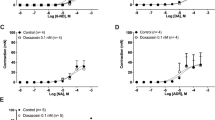Abstract.
In the present study we examined the effect of α-adrenergic regulation of active transepithelial Na+ absorption across the isolated frog skin epithelium. α-Adrenergic stimulation was achieved by addition of the adrenergic agonist noradrenaline in the presence of the β-adrenergic blocker propranolol. α-Adrenergic stimulation inhibited basal as well as antidiuretic hormone (ADH)-stimulated Na+ transport. The ADH-induced increase in Na+ transport was accompanied by a membrane depolarisation due to an increase in the apical Na+ permeability. The subsequent application of noradrenaline inhibited the Na+ transport and repolarised the membrane potential, suggesting that α-adrenergic stimulation had reduced the apical Na+ permeability. The inhibition was abolished by the α2-adrenergic antagonist yohimbine whereas it was insensitive to the α1-adrenergic antagonist prazosin. α-Adrenergic stimulation had no effect on the cytosolic free [Ca2+] ([Ca2+]i). Incubation of the epithelium in the presence of ADH increased the cellular adenosine 3′,5′-cyclic monophosphate (cAMP) content, an increase which was abolished by α-adrenergic activation. The effect of α-adrenergic stimulation on cAMP production was abolished by the α2-adrenergic antagonist yohimbine. We conclude that the noradrenaline-induced inhibition of the ADH-stimulated Na+ absorption and cAMP content is mediated by activation of α2-adrenoceptors. The data further indicate that the principal cells of the epithelium do not express α1-adrenoceptors. The noradrenaline-induced inhibition of the ADH-stimulated Na+ transport was concentration dependent, with 0.24±0.03 µM eliciting a half-maximal response . This α2-adrenergic-mediated down-regulation of Na+ absorption is achieved at a concentration of noradrenaline which begins to activate the NaCl secretion via the skin glands. The α2-adrenoceptors therefore appear to have considerable physiological importance.
Similar content being viewed by others
Author information
Authors and Affiliations
Additional information
Received after revision: 16 February 2001
Electronic Publication
Rights and permissions
About this article
Cite this article
Gudme, C., Larsen, A. & Nielsen, R. α2-Adrenoceptors inhibit antidiuretic hormone-stimulated Na+ absorption across tight epithelia (Rana esculenta). Pflügers Arch - Eur J Physiol 442, 346–352 (2001). https://doi.org/10.1007/s004240100560
Received:
Accepted:
Published:
Issue Date:
DOI: https://doi.org/10.1007/s004240100560




